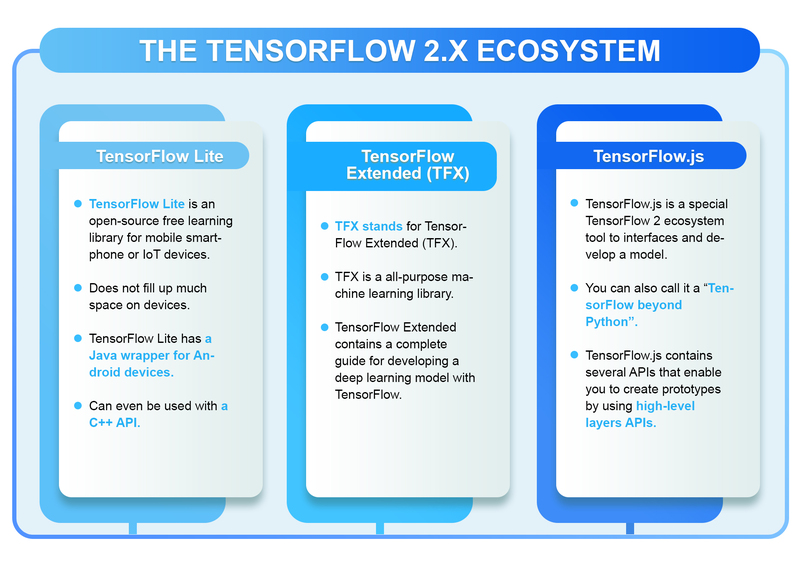TensorFlow is one of the most recognized deep learning guides in the world. It was first launched in 2015 by the Google Brain Team to create machine learning opportunities and great learning models. Moreover, this popular library helps to break down complex data as well as come up with neural network prototypes to help solve some business problems. TensorFlow is an important framework widely used by big companies to unravel some mysteries in business.
More importantly, TensorFlow 1 and TensorFlow 2 are the pioneer versions of the TensorFlow sophisticated library. TensorFlow 2 is simply an updated version of TensorFlow 1 and it is programmed with more advanced features. In this article, we'll dive deeper into the concept of TensorFlow, most especially the revised version which is "TensorFlow 2."
What Is New?
Originally, TensorFlow uses data flow graphs to solve numerical computations and build learning models. Both TensorFlow 1 and TensorFlow 2 operate this way. However, unlike TensorFlow 1, TensorFlow 2 is more comprehensive and easier to use. Let's say it is a smarter version of TensorFlow.
TensorFlow 2 is an extensive library that serves as a guide for researchers, developers and companies that want to develop deep learning or machine learning applications. The interfaces of TensorFlow 1 and TensorFlow 2 are programmed in Python, Java and other top-notch programming languages. TensorFlow 2 codes are written in this form, "TensorFlow2.x”
More so, a lot of improvements such as bug fixes and the likes have been made on TensorFlow 2 when compared to its previous version. One genuine advancement of TensorFlow 2 over TensorFlow 1 is the presence of an ecosystem of tools. Aside from the Tensor library, the TensorFlow 2.x ecosystem made available some user-friendly tools.

Down here are some functional tools on the TensorFlow 2.x ecosystem. Let's take a look at them.
TensorFlow Lite
TensorFlow Lite is an open-source free learning library that can be accessed on a mobile smartphone or IoT devices. TensorFlow lite does not fill up much space on devices. This is why it is described as a lite version of TensorFlow. TensorFlow Lite has a Java wrapper for Android devices. Thus, you can use it on Android or even an IOS with a C++ API.
Besides, it is quite easy to create machine learning using TensorFlow lite. All you need to do is follow some simple steps. First, develop a model with a high-end machine. Then convert the model to utilities using the.tflite layout .Lastly, present the model on any device you want.
TensorFlow Extended (TFX)
TFX is a TensorFlow 2 tool and an all-purpose machine learning library. Plus, TensorFlow extended includes a complete guide for developing a deep learning model with TensorFlow.
TensorFlow.js
TensorFlow.js is a special TensorFlow 2 ecosystem tool that makes it easier to navigate through the interfaces and develop a model. You can also call it a "TensorFlow beyond Python." TensorFlow.js contains several APIs that enable you to create prototypes by using high-level layers APIs or the low-level JavaScript linear algebra library.
What Are The Highlights?
Since TensorFlow 2 is a new update for TensorFlow 1, there are some noteworthy transition advancements you should know. These two TensorFlow versions have similar modus operandi, however, TensorFlow 2 has a few peculiar features.
Below are some highlights of TensorFlow 2:
• TensorFlow 2 was introduced in September 2019.
• TensorFlow 2 enables eager execution and faster creation of models.
• This library gives room for proper experimentation and research.
• On any platform, TensorFlow 2 has strong prototype developments in production.
• TensorFlow 2 reduces duplication and eliminates unwanted APIs. This helps to simplify the APIs.
• It functions well with multi-dimensional arrays.
• TensorFlow 2 embraces quick model building and debugging.
• This library makes it easier to calculate voluminous data sheets and computations.
• Lastly, TensorFlow 2 has a large community and allows a TensorBoard to visualize the built model.
Also, when weighed closely with TensorFlow 1, TensorFlow 2 shows some degree of uniqueness. Let's explore the special functions and components of TensorFlow 2.
TensorFlow 2 Vs TensorFlow 1:
• Unlike TensorFlow 1, TensorFlow 2 allows users to build and run models in no time.
• TensorFlow 2 offers API cleanup.
• There's an AutoGraph and tf.function() feature in TensorFlow 2.
• Unlike TensorFlow1, TensorFlow 2 does not require a tf.variable_scope.
• TensorFlow 2 uses "Keras" as its official high-level API.
Common Issues With TensorFlow 2
Just as TensorFlow 2 has a lot of boons, it also has its bane. There are some common problems you can encounter while using the TenserFlow 2 library. When you use TensorFlow 2 for object detection, the most common issue that can spring up is "Python crash."
For instance, you might be testing your model by running some Python object detection script. And within a few seconds, your windows notifies you that Python has crashed. The python crash may be due to the wrong installation of the cuDNN library. Therefore, to use TensorFlow 2 efficiently on any device, ensure you install the correct version of cuDNN which is "cuDNN v7.0.5." And aside from the python crash, there are also other issues with TensorFlow 2. Conclusion
Conclusions
TensorFlow 2 is a strong framework that can help build models using voluminous data. And unlike its preliminary version (TensorFlow 1), TensorFlow 2 interface is easier to understand and navigate through. For beginner developers, it is quite simple to install TensorFlow 2. You can install it using Anaconda (on a local system) or Google Colab by Google TensorFlow's Team.
Additionally, TensorFlow 2 has a wide range of applications such as image and text classification, building and compilation of models, etc. This article spotlights all you need to know about TensorFlow 2. Thus, any industry that intends to make the most out of their business by creating brilliant models should try out TensorFlow 2 and leave the framework to work its wonders.

